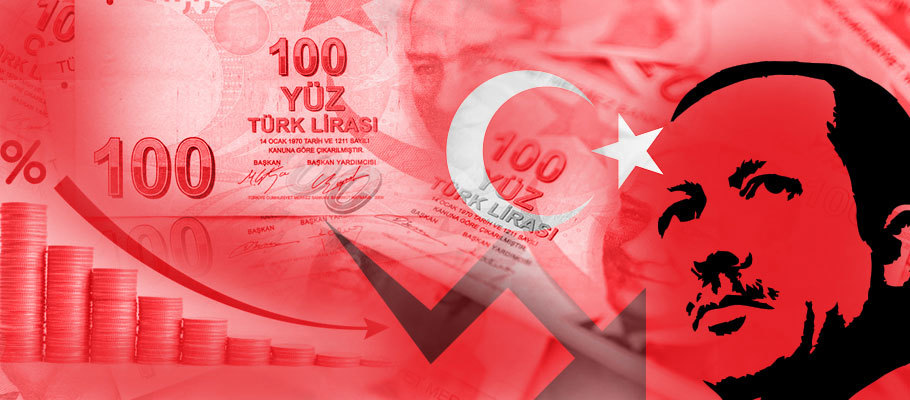
Published: August 9th, 2021
Turkish President Recep Tayyip Erdogan’s call for lower interest rates ahead of a central bank policy meeting sent the lira (TRY) into a tailspin last week. As the Friday (6th August) session drew to a close, the intervention had wiped out gains made in June and July and sent the lira tumbling to as low as 8.5718 against the greenback, down more than 3 per cent from the two-month highs reached earlier in the week.
Analysts say the rapid reversal shows how febrile investor sentiment is, with fears of undisciplined monetary easing driving inflation worries and threatening to send traders, many who’ve been lured by TRY’s impressive yields, fleeing for the door.
Commerzbank’s emerging-market economics unit told Reuters that it now sees a 55 per cent probability that lira will drop to 9.5 per dollar by year’s end, worse than the record low of 8.8007 seen in June.
‘In our analysis, it’s not this week’s shift that’s been most notable, but rather the two-month period of strength. We think that’s been unwarranted on the fundamentals.’ In a note to investors, Commerzbank analysts also said they expect the lira to slide to 10 per dollar by year-end.
Sahap Kavcioglu, governor of the Turkish central bank, has so far resisted Erdogan’s calls for slackening monetary policy and has been steadfast In his determination to keep the banks’ benchmark rate at 19 per cent. While that makes it one of the highest amongst emerging markets, the policy hasn’t done much to stifle inflation, which is running hot.
As Erdogan’s poll numbers tumble and the government deals with mounting criticism over its ineffective response to unprecedented Summer wildfires, the pressure to cut interest rates when the central bank policy committee meets on Thursday is expected to intensify.
Governor Kavcioglu has promised to keep policy rates above both forecast and actual inflation. Data released last week showed consumer prices rising in July. In principle, that should reduce the chances of a late Summer interest-rate cut, despite the president’s wishes.
Economists at Ark Capital Management in Dubai told Bloomberg Middle East that they don’t believe the central bank will be in a position to cut rates this week. ‘If anything, they will be looking to shore up their credibility under political pressure.’
For investors and traders who have seen their gains vaporised, Erdogan’s latest intervention has raised the possibility of further political interference in monetary policy. The president has fired three central bank governors during his tenure, each sacking triggering an exodus of investment and weighing heavily on the lira.
Last week the central bank lifted its year-end inflation forecast while predicting a notable slowdown in price growth for Q4. That could potentially open the door to an interest-rate cut later in the year.
TRY is down more than 11 per cent against the greenback since January, the worst emerging-market performer after the Argentine peso.
Todd Silbert, ME markets analyst at Bank of Singapore, told Bloomberg that ‘the normal thing a central bank does in a period of rising inflation is to raise rates. This hasn’t always happened in Turkey, with the negative impacts you’d expect in terms of ongoing weakness in the lira.’
At the start of July, the lira was on the up after clawing back from sharp declines experienced earlier in the year. It bucked the downside trend in a bruising time for emerging market fiats.
The lira was up 3 per cent against the dollar on 5th July, making it the best-performer amongst large emerging-market currencies. The period of stability followed a price collapse in March when Erdogan sacked the central bank governor. Despite the change in leadership, the current governor has held rates at 19 per cent earlier for four straight months, with an accelerating 17.5 per cent inflation rate likely giving him the will to hold course.
Still, the currency is twelve per cent lower against the dollar for the year-to-date, having fallen out of favour quite suddenly with overseas investors. “It appears to be doing well now because in the past it’s done so badly,” said Bank of Singapore’s Silbert. ‘There’s no one left to sell it.’
Before the country’s 2018 currency crisis, foreign investors held close to a quarter of the country’s currency debt. That figure dropped sharply to five per cent late in 2020. but started edging higher again this year. It hit 6.6 per cent in July despite the changes at the central bank. As long as the lira keeps to a stable footing, ten-year yields as high as nearly 16 per cent will continue to tempt foreign buyers.
The lira’s down-up-down YTD performance has kept it out of step with other developing economies, with currencies like the South African rand and Brazilian real steadily notching up substantial gains since January. Both have since dropped back somewhat after US Federal Reserve forecasts started to indicate that some members of its FOMC policy committee are thinking about rate rises as soon as next year. The potential for sooner-than-anticipated monetary tightening at the world’s leading central bank has given the greenback a jolt against a slate of competing majors and minors.
Analysts at emerging market debt specialists William Blair told investors in a call this week that the firm has made tactical bets on TRY in recent months, going long ‘a couple of times but always with a very short-term outlook.
‘We believe there’s a high risk that once inflation smoothes out, we will see moves toward interest rate cuts. The complexity in determining the market direction will be how investors interpret the way Turkish monetary policy is conducted, by fundamentals or by politics.’